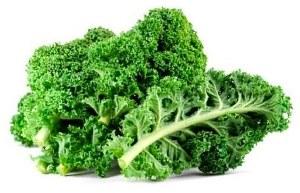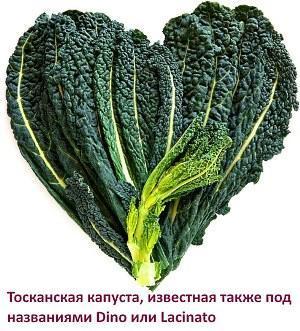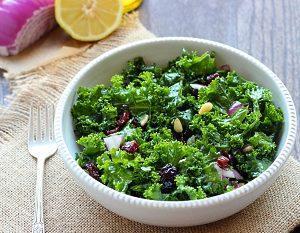Cultivation of kale and its beneficial properties
 Kale cabbage is a complete dietary and vegetarian food that is able to saturate the daily menu with vitamins and easily digestible protein and decorate a garden plot with its appearance. Kale cabbage, also known under the names "browncol" and "gruncol", is unpretentious in cultivation, because it is resistant to frost (up to -60C) and pests. Having learned about the beneficial properties of kale cabbage, you should definitely try to grow it on your own garden bed.
Kale cabbage is a complete dietary and vegetarian food that is able to saturate the daily menu with vitamins and easily digestible protein and decorate a garden plot with its appearance. Kale cabbage, also known under the names "browncol" and "gruncol", is unpretentious in cultivation, because it is resistant to frost (up to -60C) and pests. Having learned about the beneficial properties of kale cabbage, you should definitely try to grow it on your own garden bed.
Kale types

But, nevertheless, there are many types of kale cabbage:
- Curly cabbage is the most popular type of kale. It has a softer and sweeter taste than other species. As the name suggests, its leaves are very curly and wrinkled.
- Tuscan cabbage - has thin, oblong leaves with a wrinkled structure.
- Premier cabbage is a fast growing frost hardy species.
- Siberian cabbage - resistant to pests and low temperatures.
- Red Russian - differs from Siberian in expressive red winding leaves.
- Redbor F1 cabbage is red or dark purple, which is why it is often used to add color to dishes.
- Reed - can grow up to 1.9 m in height. It is characterized by a thick stem that can be used as a cane.
Whatever the type of kale cabbage, its leaves are best eaten raw, adding to salads with tomatoes, basil and young garlic, because in this case all useful substances will be preserved. If the leaves are a little harsh, then they are stewed, steamed or added to soups. Read:stewed cabbage with potatoes and meat - a recipe with a photo step by step.
Benefits of Kale Cabbage
 Because of its decorative appearance, kale kale is more often used as a festive decoration of a dish than it is used for food. And in vain, because, being the closest relative of wild cabbage, Kale retained a large amount of vitamins and minerals. The unique composition of biologically valuable substances and the extremely useful properties of Kale cabbage raise it above all green leafy vegetables, the benefits of which are truly invaluable to the body.
Because of its decorative appearance, kale kale is more often used as a festive decoration of a dish than it is used for food. And in vain, because, being the closest relative of wild cabbage, Kale retained a large amount of vitamins and minerals. The unique composition of biologically valuable substances and the extremely useful properties of Kale cabbage raise it above all green leafy vegetables, the benefits of which are truly invaluable to the body.
Consider the most beneficial properties of kale, for which it is worth growing:
- It helps to eliminate the calcium deficiency in the body, because 1 g of kale contains up to 1.35 mg of calcium, while 1 g of cow's milk contains only 1.13 mg. At the same time, it has been proven that calcium from curly cabbage is absorbed 25% better than from milk. And if you consider that some people suffer from milk protein intolerance, then Kale cabbage can be considered an irreplaceable source of calcium for the human body.
- Kale cabbage can successfully replace meat, because in its 200 grams it contains a daily dose of protein, which, like meat, contains 18 amino acids, for which it was awarded the title of "new beef". But amino acids are much easier to extract from kale cabbage!
- An excellent remedy for the prevention of vision. Kale is considered the queen of carotenoids, as one cup of cabbage contains 200% of the daily intake of vitamin A.
- The high vitamin C content makes kale a good natural antioxidant.
- Due to the high concentration of essential omega-3 fatty acids and substances such as sulforaphane and indole-3-carbinol, kale is used to prevent the formation of cancerous tumors.
- It helps in the fight against obesity, because the calorie content of Kale cabbage is only 50 kcal / 100 grams, but at the same time it saturates the body with many useful substances. For this, she takes an honorable place in dietary and vegetarian food.
- It saves lives for those who have a problem with the presence of excess elemental calcium in the body, because magnesium acts as a calcium regulator, of which there is a lot in feces.
In addition to the aforementioned useful substances, kale contains vitamins of group B, K, PP in large quantities, and from trace elements - potassium, sodium and phosphorus.
Growing cabbage kale
Since Kale cabbage does not tolerate transplanting, it is most often grown directly from seeds planted in open ground. As a cold-resistant and unpretentious plant, Kale cabbage will delight you with an excellent taste and yield, if the optimal conditions for it are observed during cultivation.

Planting seeds in open ground:
- Kale cabbage feels good in fertile soil, in which well-fertilized legumes, potatoes, cucumbers or tomatoes. From autumn, well-decomposed humus should be introduced into the soil or compost (3-4 kg per 1 sq. M) and mineral fertilizers (up to 100 g per 1 sq. m.).
- The most favorable soil is with a pH of 5.5 to 6.8. To raise the pH level, acidic compost is used, to lower it, the soil is mixed with granular sulfur.
- A sunny area or partial shade is chosen for the beds.
- Kale cabbage seeds are planted in open ground in April, when the soil temperature is not less than +4 - + 50C. But no later than 10 weeks before the first autumn frosts.
- The distance between seedlings should not be less than 45 cm.
- Before planting seeds, humus is introduced into the hole.
- In each hole, up to 4 seeds are sown to a depth of 1.5 cm, which are sprinkled with earth, watered and covered with glass or foil.
- 4-5 days after sowing the seeds, the covering material is removed and the emerging seedlings are broken through so that only one of the strongest stem remains.

Transplanting kale cabbage to the garden:
- For growing seedlings use pots with an area of 40 sq.
- Fertilize the soil with organic fertilizers or compost.
- Kale seeds are planted in pots 5-7 weeks before the last spring frost.
- You can transplant seedlings when it reaches a height of 8-10 cm and 4 developed leaves are formed on it. This takes 4-6 weeks after indoor sowing.
- Before transplanting into the garden, fertilizers are applied in the area for planting seedlings.
- Seedlings are carefully removed from the pots so as not to damage the root system.
- A hole in the soil is made so deep that the soil reaches the first leaves of the seedling. The distance between the seedlings is maintained at least 45 cm.
- Seedlings are planted in holes perpendicularly and sprinkled with soil.
- Water thoroughly.
Care:
- Fertilizing kale is recommended every 6-8 weeks.
- Watering should be carried out continuously as the topsoil dries out.
- To prevent decay and discoloration of leaves, carry out soil mulching... But you need to make sure that the plant has reached a height of 15 cm.
- Discolored or withered leaves should be removed immediately so as not to provoke an attack by harmful insects.
Collection:
- Depending on the type, kale cabbage is harvested 70-95 days after sowing or 55-75 days after transplanting seedlings.
- You can collect edible leaves when the plant has reached 20 cm in height.
- The outer leaves are plucked first.
- To collect the plant completely, it is cut at a height of 5 cm from the soil surface. Then new leaves will begin to form on the remaining stem.
- Leaves must be picked as they ripen, otherwise they will become tough and bitter over time.
If you adhere to these recommendations, the taste of home-grown kale will be delicate and sweet, and the leaves will be soft in structure.
Fresh kale can be stored in the refrigerator for up to one week, but it is even better to freeze it, because the taste of kale becomes even sweeter from this. Thus, you can provide your family with a fortified and protein-complete diet until the next harvest.